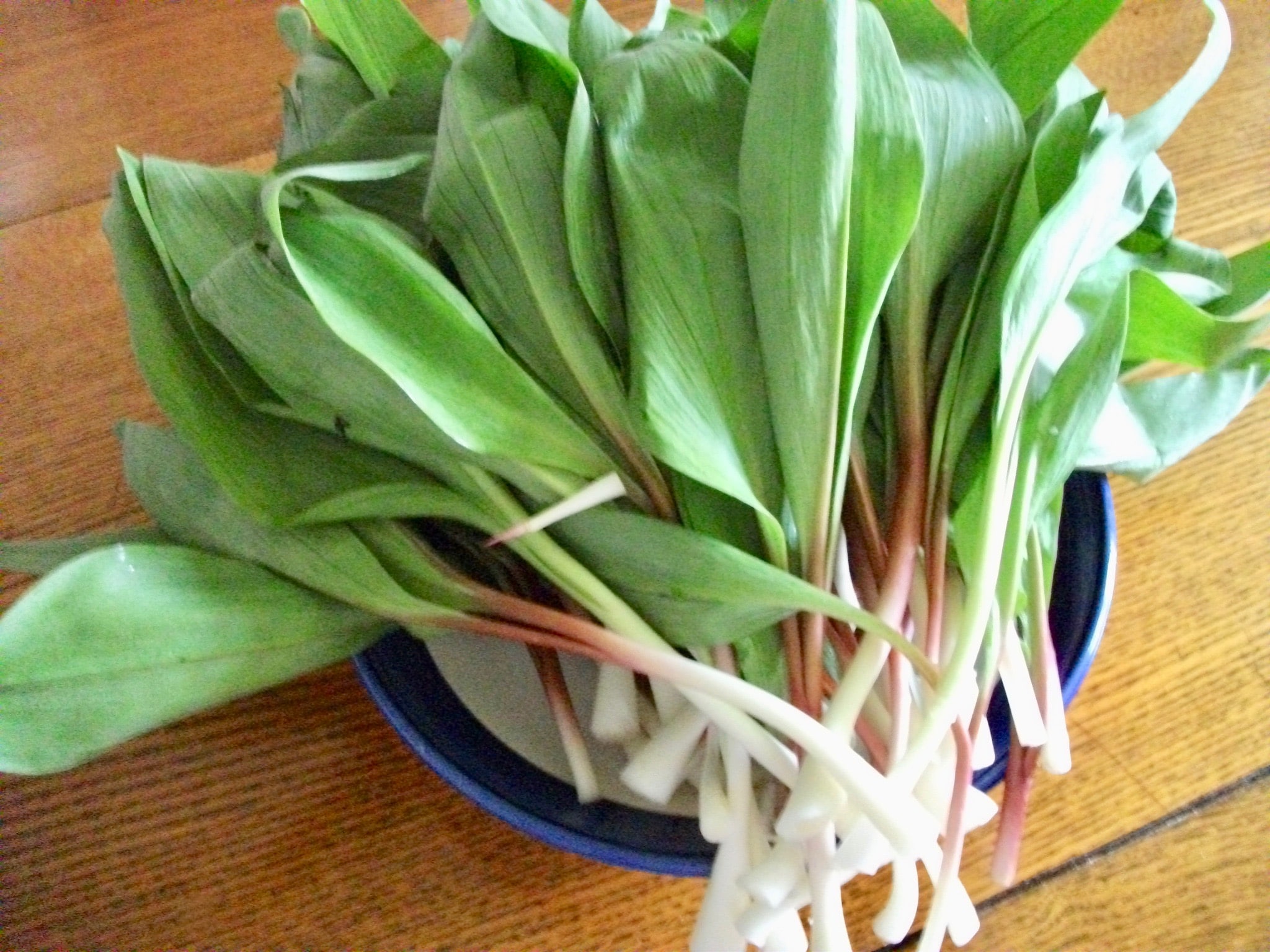Bitter and pungent-tasting foods are largely absent from the Standard American Diet (SAD diet)—a way of eating characterized by refined grains, sugar (in all of its refined and processed forms), high intake of factory farm red meats, processed meats (think bacon, sausage, hot dogs, deli meats) and unhealthy fats, like vegetable oils (e.g., canola oil, safflower oil, soybean oil, etc) and trans fats (e.g., Crisco). The predominant flavors of a SAD diet are typically overly salty and hyper sweet.
Yet, in the spring, bitter or pungent foods play an important role in preparing our bodies for warmer weather and lighter fare. Certain pungent spring vegetables—dandelion greens, mustard greens, ramps (wild leeks) and other allium (scallions, chives, cultivated leeks)—also have a cleansing effect, beneficial for our liver, our blood and our immune system.
In Chinese Medicine, spring is a time of regeneration and rejuvenation—and many cleansing regimens target the liver, the main organ of detoxification. According to the philosophy of Chinese medicine, the liver is responsible for Qi (energy) flowing throughout the body. When the liver functions smoothly, so, too will the body, in terms of physical and emotional activity. Symptoms of an overburdened liver may manifest as dry skin, acne, constipation, gas, bloating and headaches.
Bitter foods also enhance digestion. By improving digestion, the body is better able to absorb nutrients and eliminate waste (including toxins).
Spring Tonic Greens
Spring foods that support the detoxification process include the following:
1. Allium (onion) family: Onions, garlic, shallots, chives, scallions and leeks (cultivated) and ramps (wild leeks).
Organosulfur compounds, specifically, allyl sulfides, give allium vegetables their distinct pungent aroma and bite. Allyl sulfides can help lower blood pressure and inhibit tumor growth. Allium vegetables are also abundant in polyphenols (antioxidants), and rich in flavonoids, in particular, quercetin, an antioxidant that helps reduce inflammation (by preventing the oxidation of fatty acids in the body). Because of its antihistamine properties, quercetin can also help mitigate allergic response. Regular consumption of allium can help boost the immune system, increase antioxidant levels, fight inflammation and help eliminate toxins. Studies suggest that allium vegetables, especially garlic, have a cholesterol-lowering effect; they have also been linked to a reduced risk of certain cancers, including breast, prostate, stomach and colon.
Among pungent spring vegetables, ramps (wild leeks) stand out as being the “stinkiest” in the allium family. The unabashedly pungent and aggressive flavor of ramps are a testament to an abundance of sulfur compounds. They are also a rich source of the trace mineral selenium, which studies have shown to reduce the risk of certain cancers, like colon, lung, liver, gastric and esophageal.
2. Cruciferae or Brassicaceae family: Broccoli, cabbage, Brussels sprouts, cauliflower, collard greens, kale, kohlrabi, turnips, radishes, horseradish, bok choy, arugula and mustard greens.
An excellent source of folate and chlorophyll, cruciferous vegetables are rich in glucosinolates, sulfur-containing compounds that can contribute to a bitter or “hot” (spicy) taste. Glucosinolate compounds contain cancer-fighting properties, which help increase the liver’s ability to detoxify carcinogens; they may play a role, too, in slowing the growth of already existing cancerous tumors. Regular consumption of brassica vegetables can help protect against rectal and colon cancer.
Among cruciferous dark leafy greens, mustard greens are distinctly hot and spicy. They are very high in gluconsinolate content, ranking second only to Brussels sprouts. When cooked (steamed), mustard greens will bind with bile acids (generated in the liver) in the digestive tract, enabling bile acids to be excreted from the body, which has an overall cholesterol-lowering effect.
3. Taraxacum officinale: Dandelion (roots and leaves).
Those pesky dandelions—which we try so hard to banish from suburban lawns—are actually a nutrition-packed spring superfood. Long regarded as a “liver tonic”, dandelion has been used medicinally by many cultures to treat various gastro-related issues. Native Americans used dandelion as a tonic for kidney disease, heartburn and upset stomach. Traditional Chinese medicine has used dandelion to treat breast problems, such as lack of milk flow, appendicitis and stomach problems. Europeans took dandelion as a therapeutic remedy for fever, boils, diabetes and diarrhea.
The dandelion root contains taraxacin, a bitter crystalline compound that helps stimulate digestion, as well as inulin and levulin, starch-like substances that may help balance blood sugar. Because inulin is not digested or absorbed by the stomach, it heads to bowels, where it encourages growth of bacteria that improves bowel function.
Dandelion leaves are mineral-rich (iron, magnesium, potassium, zinc, manganese, copper, choline, calcium, boron and silicon) and fresh dandelion leaves are an exceptional source of vitamin A as well as vitamins, C, K and B-complex. Herbalists use dandelion root to detoxify the liver and gallbladder, and dandelion leaves to promote kidney function. Dandelion greens also have a diuretic effect, increasing urination, which can alleviate fluid retention and lower blood pressure.
Where to Find
You can find many of these pungent spring greens or cruciferous vegetables at the farmers’ market. Many allium vegetables can also be found at the supermarket.
If you’re knowledgeable and game, you can forage for dandelions or ramps—considered a spring delicacy in certain parts of the country, like Appalachia. You can forage for dandelion greens in your own backyard (just make sure that you are not foraging on a chemically treated lawn); the best time to pick dandelions, is before their flowers blossom. Ramps grow in wooded areas, around streams and even near roadsides (but avoid these since they absorb toxins from road sludge).
When foraging, it’s best to dress in a long-sleeved shirt and long pants with the cuffs tucked into socks and shoes, especially if you’re in a heavily wooded area or near a stream to minimize your exposure to ticks and mosquitos.
How to Prepare
»» Mix young dandelion leaves or baby arugula in a salad or add to smoothies.
»» Puree raw ramps into a pesto; or cook them by braising or sautéing ramps in olive oil with plenty of garlic.
»» Braise or sautee dark leafy greens, like mustard greens, with garlic or ginger in olive oil or coconut oil to tame their pungent bite.
»» Add wild grens—ramps or dandelion greens—to a fish stew.
»» Toss lardons (bacon) with dandelion greens sautéed with garlic in olive oil for a warm dandelion and bacon salad.
RECIPE: Garlicky Braised Ramps
1 pound ramps, washed well and bulbs cleaned of dirt, separate white
bulb from stalk and roughly chop; set aside
1-1/2 tablespoons extra-virgin olive oil
4-5 garlic cloves, minced
1/4 cup water
Heat wok or Dutch oven with olive oil over medium-high heat. When the oil is hot (but not smoking), add chopped white ramp bulbs. Saute 2-3 minutes, or until the white bulb softens and browns somewhat. Lower heat to medium-low. Add minced garlic; sauté until just incorporated. Add green ramp leaves, raising heat to medium. Saute until all the leaves wilt, about 2-3 minutes. Add 1/4 cup water to loosen any ramps or garlic that may be sticking to the bottom of pan, stirring well.
Reduce heat to low, cover and simmer apx. 8 minutes. If there is any residual water, remove lid and raise heat, stirring ramps until all the water has evaporated. Season with Celtic sea salt, to taste. Serve.


